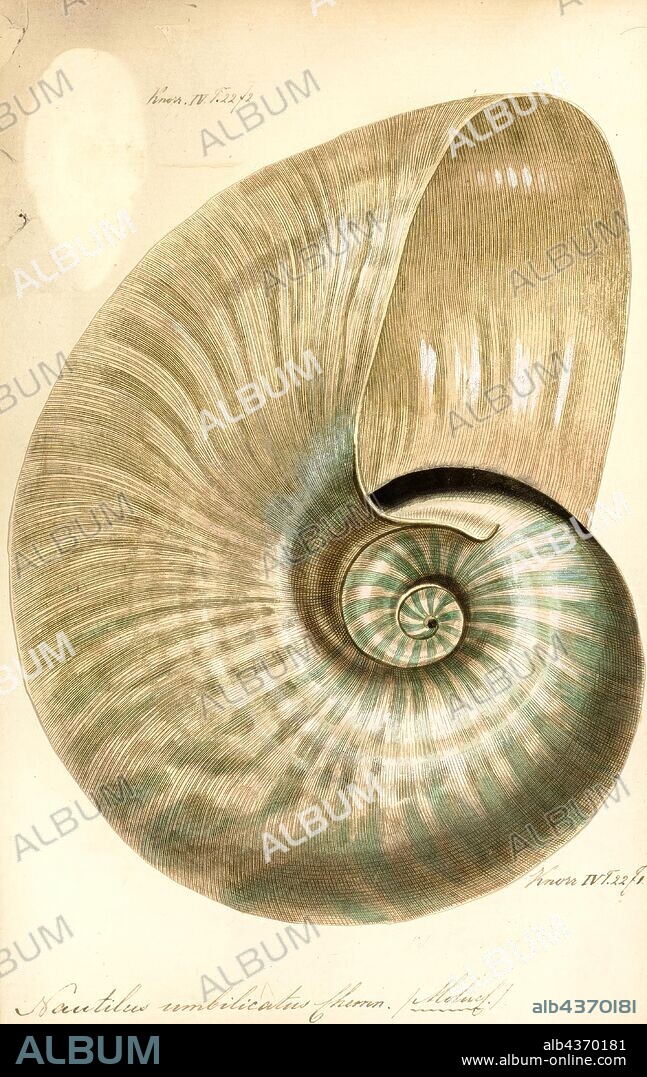alb4370181
Nautilus umbilicatus, Print, Allonautilus scrobiculatus, also known as the crusty nautilus or fuzzy nautilus, is a species of nautilus native to the waters around New Guinea, specifically New Britain and Milne Bay, and the Solomon Islands. A. scrobiculatus is instantly recognizable by the large open umbilicus, which is around 20% of the shell diameter at its widest point. This species, along with the closely related A. perforatus, were originally placed in the genus Nautilus, but have recently been given their own genus on account of significant morphological differences. The most obvious are features of the shell, including crease and an encrusting layer (periostracum) that covers most of the shell. Gills and reproductive structures also differ significantly from members of the genus Nautilus. The shell is usually up to around 18 cm in diameter, although the largest specimen ever recorded measured 21.5 cm. The species was thought to have gone extinct after 1986, but was rediscovered in July 2015. According to The Telegraph, "the allonautilus scrobiculatus has inhabited the earth for 500 million years and has only been seen twice, until now".

|
Add to another lightbox |
|
Add to another lightbox |



Buy this image.
Select the use:

Caption:
Nautilus umbilicatus, Print, Allonautilus scrobiculatus, also known as the crusty nautilus or fuzzy nautilus, is a species of nautilus native to the waters around New Guinea, specifically New Britain and Milne Bay, and the Solomon Islands. A. scrobiculatus is instantly recognizable by the large open umbilicus, which is around 20% of the shell diameter at its widest point. This species, along with the closely related A. perforatus, were originally placed in the genus Nautilus, but have recently been given their own genus on account of significant morphological differences. The most obvious are features of the shell, including crease and an encrusting layer (periostracum) that covers most of the shell. Gills and reproductive structures also differ significantly from members of the genus Nautilus. The shell is usually up to around 18 cm in diameter, although the largest specimen ever recorded measured 21.5 cm. The species was thought to have gone extinct after 1986, but was rediscovered in July 2015. According to The Telegraph, "the allonautilus scrobiculatus has inhabited the earth for 500 million years and has only been seen twice, until now".
Credit:
Album / quintlox
Releases:
Image size:
2882 x 4558 px | 37.6 MB
Print size:
24.4 x 38.6 cm | 9.6 x 15.2 in (300 dpi)
Keywords:
18 CM • 1986 • 20% • 500 MILLION YEARS • A • ACCORDING • ACCOUNT • ALLONAUTILUS SCROBICULATUS • CHARACTERISTIC • CLOSELY RELATED A • COVERS • CREASE • CRUSTY NAUTILUS • DIAMETER • DIFFER SIGNIFICANTLY • EARTH • ENCRUSTING LAYER • FEATURES • FUZZY NAUTILUS • GENUS NAUTILUS • GILLS • GIVEN • GONE EXTINCT • INHABITED • INSTANTLY RECOGNIZABLE • JULY 2015 • LARGE OPEN UMBILICUS • LARGEST SPECIMEN • MEMBERS • MILNE BAY • NAUTILUS NATIVE • NAUTILUS UMBILICATUS • NEW GUINEA • OBVIOUS • ORIGINALLY PLACED • OWN GENUS • PERFORATUS • PERIOSTRACUM • PRINT • RECENTLY • RECORDED MEASURED 21.5 CM • REDISCOVERED • REPRODUCTIVE STRUCTURES • SCROBICULATUS • SHELL DIAMETER • SHELL • SIGNIFICANT MORPHOLOGICAL DIFFERENCES • SOLOMON ISLANDS • SPECIES • SPECIFICALLY NEW BRITAIN • TELEGRAPH • TELEGRAPHS • THOUGHT • TWICE • USUALLY UP • WATERS • WIDEST POINT
 Pinterest
Pinterest Twitter
Twitter Facebook
Facebook Copy link
Copy link Email
Email
